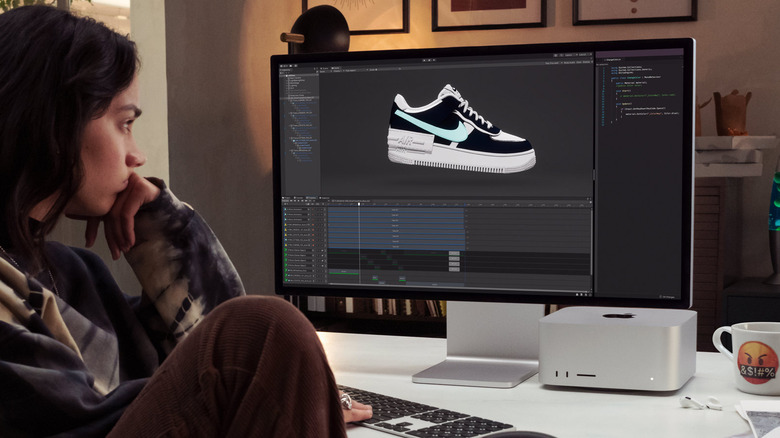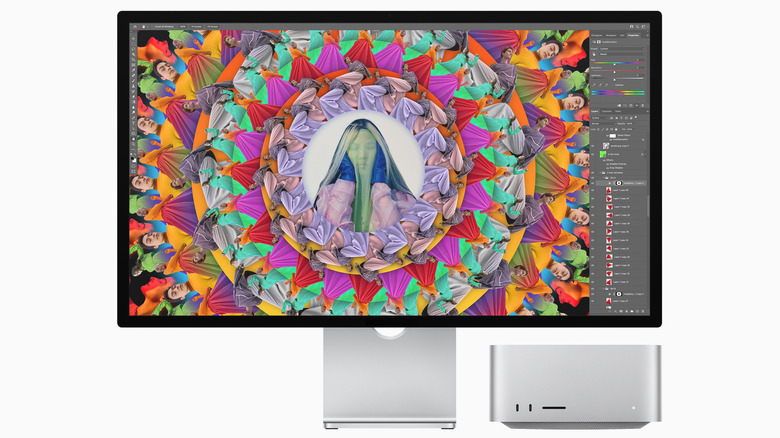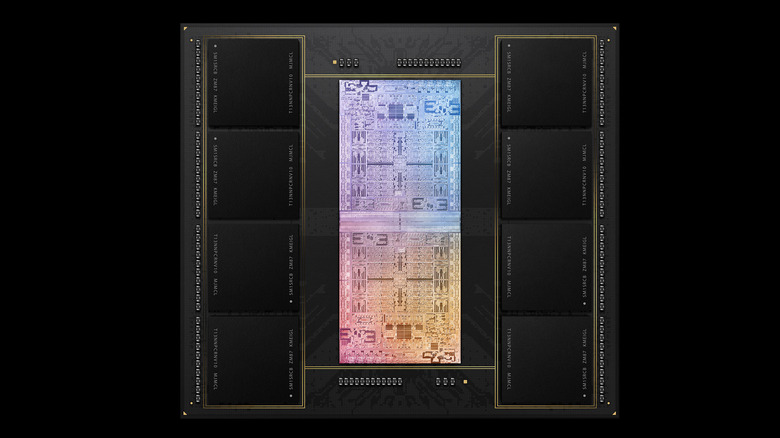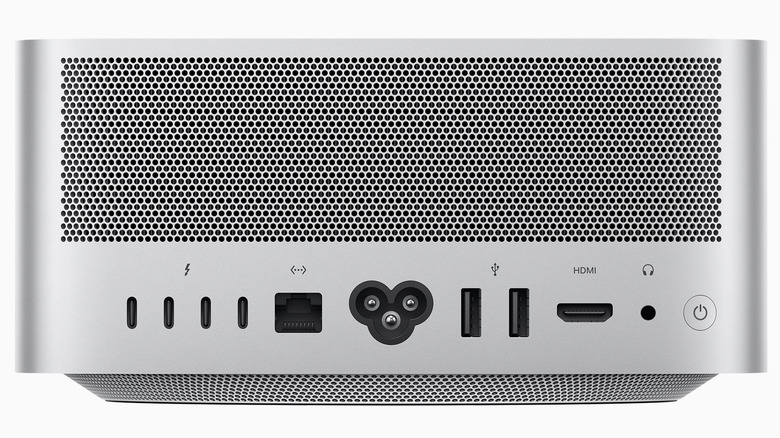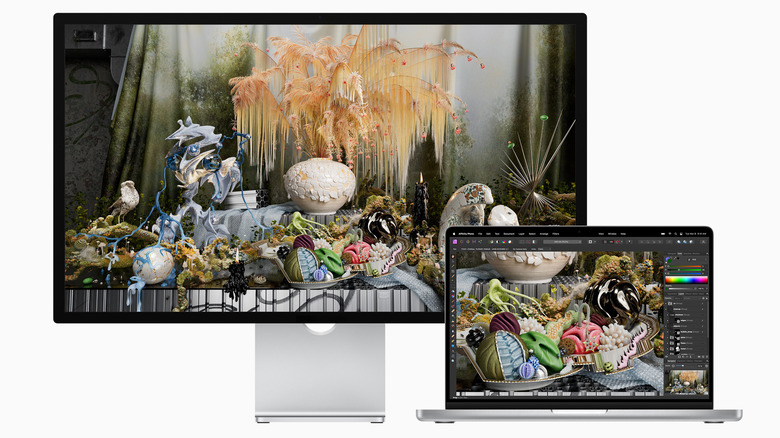The 5 Coolest Features Of The Apple Mac Studio
Now that the Mac Studio is official, it's time to take a look at what makes it stand out — other than the name and the fact that it's "the newest one," that is.
Apple spent a decent portion of its March 2022 keynote talking about its latest piece of desktop hardware, along with the new M1 Ultra chip powering it and the new Studio Display monitor meant to go with everything. The full package (Mac Studio, Studio Display, Magic Keyboard, and Magic Mouse) comes with a roughly $5,900 US price tag if you want the M1 Ultra version.
"Mac Studio ushers in a new era for the desktop with unbelievable performance powered by M1 Max and M1 Ultra, an array of connectivity, and a compact design that puts everything users need within easy reach," said SVP of Worldwide Marketing Greg Joswiak in Apple's press release. "And Studio Display — with its stunning 5K Retina screen, along with the best combination of camera and audio ever in a desktop display — is in a class of its own."
Performance
Performance is the Mac Studio's biggest advantage, assuming Apple's specs are accurate. The new system (using the M1 Ultra chip) boasts up to 60 times the CPU performance compared to its 28-core Mac Pro counterpart and up to 4.5 times the graphical performance of the 27-inch iMac. But it also claims to be incredibly quiet no matter how hard it's working, and does so while keeping the power draw to a relative minimum compared to similar PC hardware.
Coupled with the Studio Display (we'll get to that in a minute), an M1 Mac Ultra can manage up to 18 streams of 8K video, which is something Apple claims is a world first. And it offers up to 2.6 times the unified memory of other workstation graphics cards (128GB compared to 48GB of video memory).
The M1 Max version is no slouch either, claiming up to 2.5 times the CPU speeds and up to 3.4 times the graphical performance of the 27-inch iMac — and it's up to 7.5 times faster than the 27-inch iMac in general, apparently. It's also capable of transcoding videos at 3.7 times the speed of the 16-core Mac Pro
M1 Ultra
The M1 Ultra itself is also an interesting piece of tech. Not just because it looks to be a very powerful processor(without being an energy hog), but because it's actually two M1 Max chips combined into one. According to Apple, a new type of hardware architecture it's calling "UltraFusion" allows the two separate chips to work together as a single processor, maintaining high performance and memory bandwidth without a significant increase to the amount of energy it requires to function.
Mac apps and macOS Monterey in general are also meant to scale up with Apple Silicon, meaning that they should be able to start taking advantage of the increase in CPU, GPU, and memory bandwidth supplied by the M1 Ultra without any updating. It won't work for absolutely everything, but even apps that haven't been updated to "Universal" (i.e., scale with Silicon) will see improved performance with the M1 Ultra by way of Rosetta 2.
Connectivity
Being a modern Mac desktop, the Studio also has a very compact form factor while still managing to offer a number of connection ports of various shapes and sizes. Two USB-C ports support 10GB per second transfer with M1 Max or 40GB per second with Thunderbolt 4 for the M1 Ultra.
There's also an SD card slot and a display connection port that can handle up to a 4K TV. Then along the back, you have four Thunderbolt 4 ports, an HDMI port, a 10GB Ethernet port, a pro audio jack, and two USB-A ports. These are joined by non-physical connection options like built-in WiFi 6 and Bluetooth 5.0.
So, overall you get a lot of connection ports for a lot of different types of cables and devices right out of the box, without the need for an external hub or any other extra hardware. And considering that the Mac Studio itself is compact enough to be mistaken for a connection hub, that's saying something.
Sustainability
The hardware is also built with its environmental impact in mind, using recycled materials for a lot of its components in addition to the previously-mentioned reduced power draw — which Apple says results in up to 1,000 fewer kilowatt-hours being used per year compared to similar PC desktops. Magnets, the tin in the solder used for the main logic board, the plastic and aluminum used for various other bits, and even the packaging come from recycling.
It's mostly in service of Apple's plan to be carbon neutral by 2030, though that's not exclusive to the Mac Studio in particular. Though with all of the recycled materials being used in manufacturing, the new model does go a long way towards realizing the company's net-zero climate impact goals. At least in terms of the hardware itself, as this won't particularly have much — if any — impact on the fossil fuels being used for shipping and distribution.
Studio Display
Then there's the Studio Display itself, which isn't technically part of the Mac Studio as it's a separate component, but it's been designed specifically to complement the new desktop.
The new model is a sizable 27-inch 5K True Tone retina display that can automatically adjust the screen's "temperature" to better fit lighting conditions, plus it packs more than 14.7 million pixels, support for more than 1 billion colors, and comes with an option for nano-texture glass — like the Pro Display XDR uses — that can drastically reduce glare.
The Studio Display also has a built-in 12MP Ultra Wide camera that uses the A13 Bionic chip with Center Stage support to provide what Apple refers to as "the ultimate video conferencing display." This is in addition to its three-microphone array, six-speaker sound system, force-canceling woofers (four of them), and two high-performance tweeters — all of which support Dolby Atmos spatial audio.
And if you wanted, you could even connect the Studio Display (up to three of them, really) up to a MacBook Pro to add extra screens to your workspace — or just straight-up fast charge the laptop as it provides 96W of power through any of its three USB-C connection ports.
